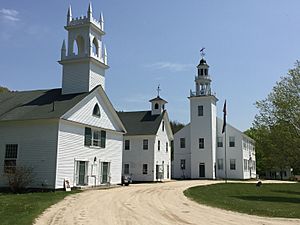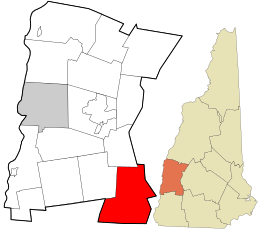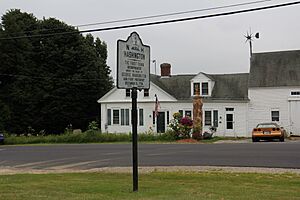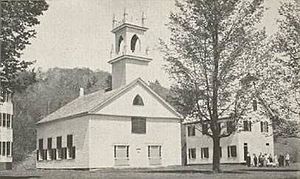Washington, New Hampshire facts for kids
Quick facts for kids
Washington, New Hampshire
|
|
|---|---|

Washington Congregational Church, Center School, and Town Hall (from left)
|
|

Location in Sullivan County and the state of New Hampshire
|
|
| Country | United States |
| State | New Hampshire |
| County | Sullivan |
| Incorporated | 1776 |
| Villages |
|
| Area | |
| • Total | 47.7 sq mi (123.5 km2) |
| • Land | 45.7 sq mi (118.4 km2) |
| • Water | 2.0 sq mi (5.1 km2) 4.16% |
| Elevation | 1,507 ft (459 m) |
| Population
(2020)
|
|
| • Total | 1,192 |
| • Density | 26/sq mi (10.1/km2) |
| Time zone | UTC−5 (Eastern) |
| • Summer (DST) | UTC−4 (Eastern) |
| ZIP code |
03280
|
| Area code | 603 |
| FIPS code | 33-78980 |
| GNIS feature ID | 0873747 |
Washington is a small town in Sullivan County, New Hampshire, United States. In 2020, about 1,192 people lived there. Washington is known for its many hills, rocks, and forests. It also has 26 lakes and ponds, making it a beautiful place for vacations. Pillsbury State Park is located here.
Contents
Town History
The land for Washington was first given out in 1735 by Jonathan Belcher. He was the governor of the colonies at the time. The town was meant to be a fort to protect against attacks from Native Americans. It was called "Monadnock Number 8."
Later, in 1751, Governor Benning Wentworth gave the land again, calling it "New Concord." But no one settled there, so the plan was canceled.
Reuben Kidder bought the land and named it "Camden." The first settlers arrived in 1768 and built simple log houses. By 1773, 132 people lived in the community.
On December 13, 1776, the new American government officially made it a town. They named it "Washington" after George Washington. This was one of the first places named in his honor.
Growth and Industry
By 1830, the town's population grew to 1,135 people. People used water power from streams to run mills. These mills made many things like lumber, barrel parts, and chair parts. They also ground grain in gristmills.
Raising sheep for wool and meat was also a big business. In 1840, there were 200 farms in Washington.
A school called Tubbs Union Academy started in 1849. It didn't last long, but it once had over 100 students. The first Seventh-day Adventist Church was built in Washington in 1862. In 1886, the town even produced 53 tons of maple sugar.
Modern Washington
When railroads became popular, tourists started visiting Washington. Hotels were built near the lakes. However, many people moved to the Midwest in the 1800s. This caused the town's population to shrink. By 1960, only 162 people lived there.
Since then, Washington has grown again. Its beautiful scenery attracts tourists and people who want to retire. The town has old buildings like the Town Hall, built in 1787. The Congregational church from 1840 and the first Seventh-day Adventist Church from around 1843 are also still standing.
Town Geography
Washington covers about 123.5 square kilometers (47.7 square miles). Most of this area is land, with about 5.1 square kilometers (2 square miles) being water. The town is located in a high area where water flows in different directions. This is called a watershed divide.
The Ashuelot River flows through the western part of town. It is part of the Connecticut River system. Bog Brook flows through the center of town. It goes into Highland Lake. This lake is part of the Contoocook River system, which then flows into the Merrimack River.
Lovewell Mountain is the highest point in Washington. It is about 2,496 feet (761 meters) tall. The mountain is named after Captain John Lovewell. He used to climb it to find Indians' homes. He once killed seven Indians near its top.
The center of Washington, called the Town Common, is also very high up. It is about 1,507 feet (459 meters) above sea level. This makes it the highest town center in New Hampshire.
Neighboring Towns
Washington shares its borders with several other towns:
- Goshen (to the north)
- Bradford (to the northeast)
- Hillsborough (to the east)
- Windsor (to the southeast)
- Stoddard (to the south)
- Marlow (to the southwest)
- Lempster (to the northwest)
Town Population
| Historical population | |||
|---|---|---|---|
| Census | Pop. | %± | |
| 1790 | 545 | — | |
| 1800 | 819 | 50.3% | |
| 1810 | 820 | 0.1% | |
| 1820 | 992 | 21.0% | |
| 1830 | 1,135 | 14.4% | |
| 1840 | 1,103 | −2.8% | |
| 1850 | 1,053 | −4.5% | |
| 1860 | 897 | −14.8% | |
| 1870 | 839 | −6.5% | |
| 1880 | 682 | −18.7% | |
| 1890 | 569 | −16.6% | |
| 1900 | 464 | −18.5% | |
| 1910 | 360 | −22.4% | |
| 1920 | 308 | −14.4% | |
| 1930 | 245 | −20.5% | |
| 1940 | 278 | 13.5% | |
| 1950 | 168 | −39.6% | |
| 1960 | 162 | −3.6% | |
| 1970 | 248 | 53.1% | |
| 1980 | 411 | 65.7% | |
| 1990 | 628 | 52.8% | |
| 2000 | 895 | 42.5% | |
| 2010 | 1,123 | 25.5% | |
| 2020 | 1,192 | 6.1% | |
| U.S. Decennial Census | |||
In 2000, there were 895 people living in Washington. These people lived in 370 households, and 277 of these were families. The town had about 19.7 people per square mile. Most of the people living in Washington were White.
Many households (about 24%) had children under 18 living with them. Most households (about 68%) were married couples living together. The average household had about 2.42 people.
The population's age spread showed that about 22% were under 18. About 18% were 65 years old or older. The average age in town was 45 years. For every 100 females, there were about 105 males.
Famous People from Washington
- John C. Lord (1805–1877), a Presbyterian minister.
- Sylvanus Thayer (1785–1872), a US Army colonel. He is known as the "Father of West Point" because he helped shape the famous military academy.
- Carroll D. Wright (1840–1909), the first US Commissioner of Labor. He was also the fifth president of the American Statistical Association and the first president of Clark College.
See also
 In Spanish: Washington (Nuevo Hampshire) para niños
In Spanish: Washington (Nuevo Hampshire) para niños



